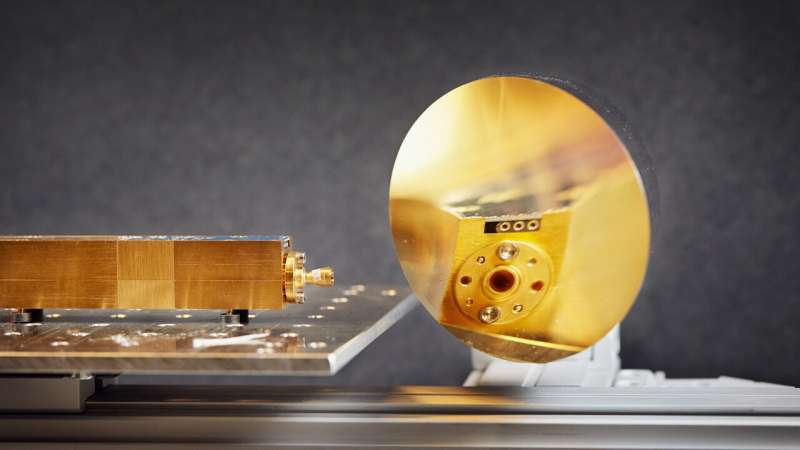This article has been reviewed according to Science X's editorial process and policies. Editors have highlighted the following attributes while ensuring the content's credibility:
fact-checked
trusted source
proofread
Radar measurements can vastly improve a key technology for the energy and production industries

Fluidized beds are used in a variety of industries and play an important role in the transition to green energy and the production of food and drugs. However, the process that occurs inside a fluidized bed is extremely complex and—due to lack of effective measurement techniques—has remained largely unknown.
Now, researchers from Chalmers University of Technology in Sweden have developed a high-frequency radar technique that can measure exactly what is happening inside a fluidized bed with unrivaled precision. This breakthrough could lead to completely new and more efficient processes in several industries, including energy conversion. The work is published in the journal Fuel.
Fluidized bed combustion is one of the leading technologies used in the world's thermal power plants. This technology converts solid fuels, such as biomass and waste, into district heating and electricity. Fluidization technology is also fundamental to many other processes that are expected to play an important role globally in the transition of energy systems, and in circular resource flows—such as in carbon capture, energy storage and the production of hydrogen and other fossil-free fuels.
Researchers at Chalmers University of Technology have now developed a radar technique able to provide a detailed characterization of the flow of solids in fluidized beds, the lack of which has been holding back the development of these processes.
Fluidized beds are already the most effective technology for converting solid biofuels into energy. This technology results in an efficient and consistent rate of combustion because the solid particles assume a liquid-like state which helps to distribute the heat homogeneously in the combustion chamber. In brief, fluidization technology is based on a gas being blown through a bed of small sand-like particles in a reactor, so that these solid particles, the fuel and the gas, become thoroughly mixed.
Like a sandstorm and a wildfire in one
In order to achieve even greater efficiencies in this process, you need to be able to understand and control how the solid particles behave in the mixture. But the reactor environment is often hot, dirty and corrosive—like a sandstorm and a wildfire in one—effectively preventing any type of measurement and thus limiting our understanding of what is actually happening inside the reactor.
The Chalmers researchers' new solution to this problem is an extremely high-frequency radar technique that can measure the flows of solid particles in fluidized beds with unrivaled precision. Inspired by the pulse-Doppler radar used to track weather phenomena such as rain or snow, this is the first time the technique has been demonstrated in the context of a fluidized bed. This breakthrough is now expected to pave the way for new and more efficient processes in a number of industries.
"The use of the high-frequency terahertz radar instrument demonstrated in our study has the potential to revolutionize how fluidized bed technology can be designed and used in many different industrial sectors—from energy conversion to the food industry and drug production. This is one of very few demonstrations of the use of pulse-Doppler radar technique at submillimeter wave frequencies, and it is the first time ever that it has been used for making measurements in a fluidized bed," says Diana Carolina Guío Pérez, researcher in energy technology at Chalmers.
Unrivaled measurement accuracy
While the measurement techniques used in fluidized beds are normally low-resolution, produce results that are difficult to interpret, or cause disturbances in the flow, the Chalmers researchers' high-frequency terahertz radar technique can penetrate the reactor from the outside and measure the behavior of the particles inside it without disturbing the flow. The radar technique can also measure the velocity and concentration of the solid particles simultaneously with great precision and high resolution in time and space. This means that even minimal changes in the flow can be detected in real-time, which is important when monitoring and controlling industrial processes.
In the researchers' study, the technique was demonstrated in practice, for the first time ever, in a three-meter high circulating fluidized bed boiler. Their findings showed a measurement quality that exceeded the quality achieved by the methods previously used in the field by a big margin.
"We have been able to show that pulse-Doppler radar technique at frequencies up to 340 GHz can measure both the distribution of particles and their velocity inside a process reactor at a much higher resolution than other technologies can. This is information that has long been lacking in the field and will make it possible to improve and scale up process reactors and—in the case of energy conversion—reduce emissions of unwanted residual products," says Marlene Bonmann, post-doc at the Terahertz and Millimeter Wave Laboratory at Chalmers University of Technology.
"The knowledge that can be acquired with our high-frequency terahertz radar technique has the potential to break new ground in our understanding of solids flows in fluidized bed reactors and other solids handling units. For example, it can lead to improved operation and design of the reactors needed in existing and completely new fluidized bed-based conversion processes, such as carbon capture and storage, energy storage and thermal cycling," says Diana Carolina Guío Pérez.
More information: Diana Carolina Guío-Pérez et al, Radar-based measurements of the solids flow in a circulating fluidized bed, Fuel (2023). DOI: 10.1016/j.fuel.2023.128232


















